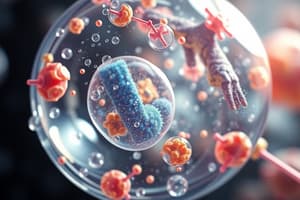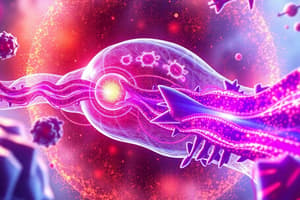Podcast
Questions and Answers
What is active transport?
What is active transport?
- Diffusion of water through a membrane
- Process of cell division
- Movement of substances from a dilute solution to a concentrated solution using energy (correct)
- Movement of substances from a concentrated to a dilute solution
Eukaryotic cells contain a nucleus.
Eukaryotic cells contain a nucleus.
True (A)
What is the primary function of chloroplasts?
What is the primary function of chloroplasts?
Photosynthesis
The __________ is a partially permeable barrier that surrounds the cell.
The __________ is a partially permeable barrier that surrounds the cell.
Match the following types of stem cells with their characteristics:
Match the following types of stem cells with their characteristics:
What is the role of mitochondria in a cell?
What is the role of mitochondria in a cell?
Osmosis involves the movement of particles from high to low concentration.
Osmosis involves the movement of particles from high to low concentration.
What is the purpose of agar jelly in biology?
What is the purpose of agar jelly in biology?
Flashcards
Active transport
Active transport
Movement of substances from a less concentrated area to a more concentrated area, using energy.
Cell membrane
Cell membrane
A barrier that surrounds a cell, allowing some substances in
Diffusion
Diffusion
Movement of particles from high to low concentration.
Cell differentiation
Cell differentiation
Signup and view all the flashcards
Eukaryotic cell
Eukaryotic cell
Signup and view all the flashcards
Mitochondria
Mitochondria
Signup and view all the flashcards
Osmosis
Osmosis
Signup and view all the flashcards
Cell specialization
Cell specialization
Signup and view all the flashcards
Study Notes
Cell Biology
- Active transport: Movement of substances from a dilute to a concentrated solution, using energy from respiration.
- Adult stem cell: Can form many different cell types.
- Agar jelly: Used in petri dishes to culture microorganisms.
- Cell differentiation: Cells become specialized for their function.
- Cell membrane: A partially permeable barrier surrounding the cell.
- Cell wall: Cellulose layer that strengthens plant cells.
- Chloroplast: Site of photosynthesis.
- Chromosomes: DNA structures containing genes, found in the nucleus.
- Concentration gradient: Difference in concentration between two areas.
- Diffusion: Spreading of particles from a high to low concentration area.
- Embryonic stem cell: Can differentiate into most types of human cells.
- Eukaryotic cell: Contains a nucleus, found in plants and animals.
- Magnification: How much larger an image appears compared to the original.
- Meristematic cells: Can differentiate into any plant cell type.
- Mitochondria: Site of respiration.
- Mitosis: Cell division producing two genetically identical daughter cells from one parent.
- Nucleus: Organelle containing the cell's genetic material (DNA) and controlling cell activities.
- Organelle: Specialized structure within a cell.
- Osmosis: Water diffusion from a dilute to a concentrated solution through a partially permeable membrane.
- Plasmid: Loop of DNA in prokaryotic cells.
- Prokaryotic cell: Does not contain a nucleus, found in bacteria.
- Resolution: Ability to distinguish two different points in a specimen.
- Specialised cells: Adapted for specific functions.
- Stem cell: Undifferentiated cell that can divide to produce many specialized cells.
- Surface area: Amount of contact an object has with its environment.
- Surface area to volume ratio (SA:V): Size of object in relation to the contact area/ environment.
- The cell cycle: Series of stages preparing the cell for division.
- Therapeutic cloning: Creating an embryo with the same genes as a patient.
- Vacuole: Organelle that stores cell sap.
Studying That Suits You
Use AI to generate personalized quizzes and flashcards to suit your learning preferences.




